The StellarMate Controller offers a unique Internet of Things (IoT) device that provides amateur astronomers with the flexibility to control a lone mount in the field or to coordinate the orchestration of a state-of-the-art observatory.
The StellarMate Controller is powered by the Open Astronomy Instrumentation protocols (INDI), Ekos which provides the cross platform control and automation and StellarMate’s KStars free astrophotography software (based on the KDE Platform) which is a cross platform astrophotography suite for Windows, MacOS, and Linux.
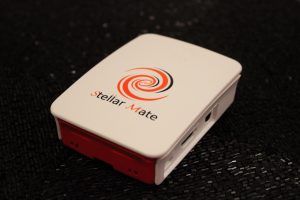 The system received a functionality boost with the release of KStars v3.3.7 and INDI Library v1.8.2. The latest release of KStars v3.3.7 packs a lot of new features and fixes across the board including ASTAP integration (an astrometric plate solver), FITS Enhancements, Guiding/PHD2 improvements and much more. The INDI Library v1.8.2 release improves support for QHY & DSLR cameras, and adds 64bit support for SBIG.
The system received a functionality boost with the release of KStars v3.3.7 and INDI Library v1.8.2. The latest release of KStars v3.3.7 packs a lot of new features and fixes across the board including ASTAP integration (an astrometric plate solver), FITS Enhancements, Guiding/PHD2 improvements and much more. The INDI Library v1.8.2 release improves support for QHY & DSLR cameras, and adds 64bit support for SBIG.
About the StellarMate Controller
StellarMate is based on years of field-experience by many amateur and professional astronomers across the world. It is powered by Linux, the same OS that powers the world’s most advanced observatories. More than 15 clients are supported including SkyCharts, PHD2, PixInsight, and many more.
It is equipped with 32GB of Class 10 MicroSD storage, so you get high transfer speed and plenty of space for your high-res images.
The device supports highly accurate GOTOs, autofocus and autoguiding capabilities, in addition to powerful image acquisition features and support for numerous mounts, CCDs, DSLRs, focusers, and much more.
You can connect your equipment (mount, DSLR/CCD, focuser, filter wheel, etc.) to StellarMate via USB/Bluetooth or by network. You then connect to the StellarMate Controller from either your mobile phone/tablet or laptop/ desktop computer. Once setup is completed, you can start controlling your imaging gear from any major platform.
The StellarMate App is available for both Android and iOS devices, and on mobile you can use KStars Lite to control your equipment.
High Level Features of the Device Include:
Auto HotSpot
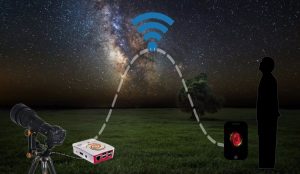 By default, the StellarMate Controller works in HotSpot mode so you can connect to it from any mobile or desktop device. If you connect it to your WiFi network, StellarMate utilizes the WiFi network as long as it is available.
By default, the StellarMate Controller works in HotSpot mode so you can connect to it from any mobile or desktop device. If you connect it to your WiFi network, StellarMate utilizes the WiFi network as long as it is available.
When you take StellarMate where a network is not available, it automatically switches back to HotSpot mode so that you never lose connectivity. In addition to HotSpot and WiFi, StellarMate can be connected to your LAN via Ethernet.
Extensive Equipment Support
StellarMate is based on industry-standard Open Astronomical Instrumentation Protocol (INDI) to drive all equipment. INDI is an open source technology and is community driven. Numerous devices are supported including, but not limited to:
– Mounts: Meade, Celestron, SkyWatcher, Paramount, IOptron, Avalon, Takahashi, Argo Navis, 10-Micron, Losmandy, EQMod, and more.
– Cameras: Canon, Nikon, Sony, & Pentax DSLRs. SBIG, QHY, QSI, FLI, Starlight Xpress, DMK, Apogee, iNova, ATIK, ZWO ASI, Morovian, Meade DSI, etc.
– Filter Wheels: ZWO, ATIK, Apogee, Starlight Xpress, FLI, QHY, and more.
– Focusers: FocusLynx, TCF-S, MoonLite, RoboFocus, NStep, Pegasus, Baader, Microtouch, and more.
– Rotators: Nightcrawler, Optec Gemini Focusing Rotator, Optec Pyxis.
– Adaptive Optics: Starlight Xpress
– Domes: Baader, MaxDomeII, NexDome, plus support for custom roll-off.
– Weather: Sky Quality Meter, Vantage Pro, WunderGround, Arduino MeteoStation.
– Spectrographs: Spectracyber & Sheyalk. Detectors: Software-Defined-Radio (SDR-RTL) based detectors.
– Auxiliary: Flip Flat, Game Pads, GPUSB, GPS.
– More drivers are added on a regular basis by the astronomical community and manufacturers.
KStars – A Modern Planetarium
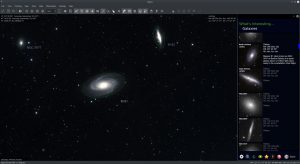 The StellarMate Controller is shipped with KStars, a modern feature-rich planetarium software for all platforms. It provides an accurate graphical simulation of the night sky, from any location on Earth, at any date and time. The display includes up to 100 million stars, 13,000 deep-sky objects, all eight planets, the Sun and Moon, and thousands of comets, asteroids, supernovae, and satellites.
The StellarMate Controller is shipped with KStars, a modern feature-rich planetarium software for all platforms. It provides an accurate graphical simulation of the night sky, from any location on Earth, at any date and time. The display includes up to 100 million stars, 13,000 deep-sky objects, all eight planets, the Sun and Moon, and thousands of comets, asteroids, supernovae, and satellites.
Hundreds of full-color catalogs, covering the whole electromagnetic spectrum from radio to gamma rays, can be overlayed directly on the sky map. It supports adjustable simulation speeds in order to view phenomena that happen over long timescales, the KStars’ Astro calculator can be used to predict conjunctions, and many common astronomical calculations.
It includes a powerful observation planner, a sky calendar tool, and an FOV editor to calculate field of view of equipment and display them. Find out interesting objects in the “What’s up Tonight” tool, plot altitude vs. time graphs for any object, print high-quality sky charts, and gain access to lots of information and resources to help you explore the universe.
Equipment Profiles
Define any number of equipment profiles and load them on the go when you need to operate specific sets of equipment. Both Local and Remote profiles are supported. Ekos can even manage uploading of the profiles to remote StellarMate Controller units so you can start your devices with ease.
Versatile FITS Viewer
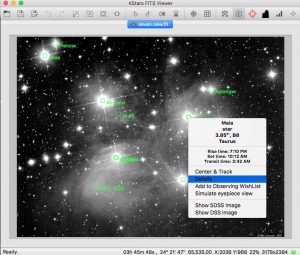 KStars simple, yet powerful FITS Viewer tool is embedded directly into Ekos and can be opened separately to examine FITS files. It supports monochrome and colors (3D Cube) FITS files in addition to bayered images.
KStars simple, yet powerful FITS Viewer tool is embedded directly into Ekos and can be opened separately to examine FITS files. It supports monochrome and colors (3D Cube) FITS files in addition to bayered images.
Images can be automatically debayered in real time. Additionally, it processes World-Coordinate-System so you can display equatorial grid overlays and pick any point within the image and command your mount to slew to it.
View and manipulate the histogram, and load up image statistics and FITS header information. You can automatically discover which objects are in your image so you can easily identify which is where.
Observation Planner
Find new targets using the Observation Planner by using the highly configurable wizard to find objects of interest using numerous parameters. Download DSS images and view objects in the Altitude vs. Time tool to plan the best time for observation.
You can even simulate how the object might appear within the eyepiece or the camera’s field of view. Find interesting objects in tonight’s sky, and when you ready, simply command your mount to go to your favorite object.
Powerful Capture Tool
Enjoy one of the most powerful image acquisition capabilities available today. You can simply capture a preview, frame an image, or even record live video stream of Jupiter.
For more complex requirements, the highly configurable Sequence Queue supports batch capture of images with filter wheel and rotator support. The images can be stored remotely on StellarMate, or download to your computer, or both. For non-parfocal filters, you can set the relative focus filter offsets to adjust focus when switching filters.
Even flat field captures can be automated with the Calibration Assistant. It supports evenly illuminated flat light sources like FlipFlat. Simply select the desired ADU and let Ekos manage the rest.
Video Recording
Capture video from supported astronomy cameras and many web cams. Select a custom ROI (Region of Interest) to exactly record what you want to reduce video bandwidth and speed up FPS. Record monochrome and color video streams in industry standard SER format.
Field Rotator Support
Directly control your rotator from Ekos, and select the desired Position Angle for your images. You can preview how a specific orientation affects your final results by adjusting the camera field-of-view (FOV) indicator in real time against on the sky map. And with the full-sky high-resolution DSS overlay, you get to see exactly how you image would appear once imaged. No more guesses.
Smart Dark Library
Dark frames can be captured under any Ekos module in order to aid in reducing noise. Every time you capture a dark frame, it is tagged and saved to the Smart Dark Library where it can be reused later on without requiring re-capture of dark frames thus saving your precious and limited observation time. The validity of dark frames can be configured including an expiry date and the temperature threshold at which the frame is not considered valid.
Sharp AutoFocus
Get pin-point stars with the Focus module. Using Half-Flux-Radius (HFR) calculations, the StellarMate Controller can automatically pick a focus star, subframe it to reduce download times, and adjust focus to get you as close as possible to the Critical Focus Zone.
Use Framing to inspect your images to make any necessary adjustments. If desired, lock the focus process to utilize a specific filter wheel. Enable In-Sequence focusing to ensure you always get sharp images during the night regardless of temperature or telescope position.
Powerful Guiding Capabilities
Use the built-in Internal guider to lock on to a star and keep it bounded during the imaging session. You can toggle directional control per axis, and adjust proportional gain to fine-tune guiding performance.
If desired, you may opt to select PHD2 or LinGuider as the external guiding applications as they are fully supported in Ekos. You can monitor guiding performance and export it to a spreadsheet for advanced analysis. Guiding pulses can be sent either via an ST4 interface, or directly to the mount if supported.
Precision Astrometry
 The days of 2- or 3-star alignment are of the past. Welcome to the world of Astrometry, where captured images are analyzed by astrometry.net and results are used to correct the mount position to achieve highly accurate GOTOs.
The days of 2- or 3-star alignment are of the past. Welcome to the world of Astrometry, where captured images are analyzed by astrometry.net and results are used to correct the mount position to achieve highly accurate GOTOs.
You can use Offline, Remote, or Online astrometry solvers and switch between them at any time.
Even if Polaris is not visible, you can still use the tool to figure out the offset. Build a mount pointing model to accomplish repeatable and reliable GOTOs during each session.
Found an image you want to capture yourself? Simply load in the image in Load & Slew and Ekos analyzes it and slews your mount to the target location so you can capture the same exact field. The camera can even rotate to match the orientation of the target within the image, so you end with the exact frame.
Easy Polar Alignment
Measure and correct polar alignment errors with the highly acclaimed Polar Assistant Tool. Ekos automatically captures and solves a number of images to accurately calculate the polar alignment errors. Follow the simple guided steps and make corrections visually until you achieve a satisfactory polar alignment for your GEM. No need to spend half an hour trying to polar align your mount when it can be done now within a couple of minutes.
Mount Modelling
Use Ekos Mount Modelling tool to train and improve your mount internal or external model. Generate all-sky target points using various options and then command your mount to begin the process.
For mounts such as EQMod, the model is updated after each sync point and once satisfied with the results, you can save your model to be used in subsequent sessions. Other mounts store the model internally (such as 10-Micron) and they can be updated accordingly to achieve superior performance for unguided imaging.
Dome Slaving
Ekos supports operation of domes and roll-off roofs. For domes, you can slave it to follow the mount as it traverses across the sky. Simply enter the required dome parameters and then let the dome track the mount motions to ensure your OTA ends up dead-center in the dome slit. Whether the mount is tracking or performing a meridian flip, the dome driver will intelligently command motion to reach the desired position using the shortest path possible.
Robotic Operation
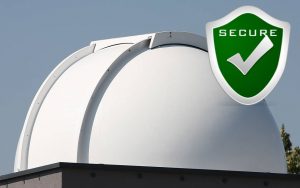 Let the StellarMate Controller capture your data while away or asleep. It covers the whole spectrum from cold startup of the observatory, target evaluation and data acquisition, to safe and secure shutdown in case of unfavorable weather conditions.
Let the StellarMate Controller capture your data while away or asleep. It covers the whole spectrum from cold startup of the observatory, target evaluation and data acquisition, to safe and secure shutdown in case of unfavorable weather conditions.
Select your target, sequence file, fill in the necessary conditions and constraints and then start the scheduler. The scheduler can operate the dome, slew to the target, and perform autofocus, autoguide, and image acquisition in a completely robotic fashion without human intervention.
Pricing
The StellarMate Controller is available for $179 plus shipping. You can learn more here.
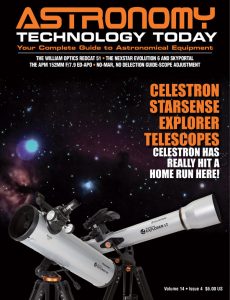 And to make it easier for you to get the most extensive news, articles and reviews that are only available in the magazine pages of Astronomy Technology Today, we are offering a 1 year subscription for only $6! Or, for an even better deal, we are offering 2 years for only $9. Click here to get these deals which only will be available for a very limited time. You can also check out a free sample issue here.
And to make it easier for you to get the most extensive news, articles and reviews that are only available in the magazine pages of Astronomy Technology Today, we are offering a 1 year subscription for only $6! Or, for an even better deal, we are offering 2 years for only $9. Click here to get these deals which only will be available for a very limited time. You can also check out a free sample issue here.

